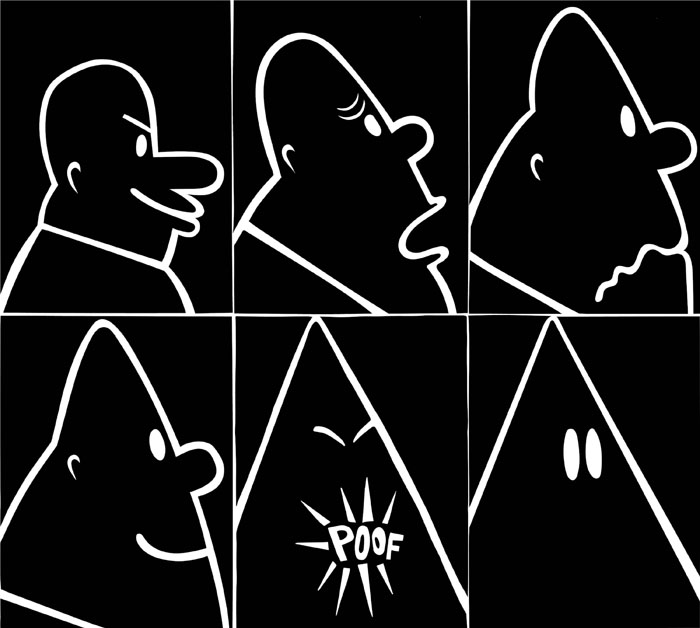
Trenton Doyle Hancock
Good Grief, Bad Grief
September 17 – October 29, 2022
Opening Saturday, September 17th, 3–7pm
Shulamit Nazarian is pleased to present Good Grief, Bad Grief, a solo exhibition by the Houston-based artist Trenton Doyle Hancock. This will be the artist’s second solo exhibition with the gallery, on view from September 17 through October 30.
Exploring a mythology that spans over twenty-five years, Hancock has created a cast of characters, a lexicon of symbols, and an evolving, non-linear narrative of epic proportion. Storytelling is at the root of the artist’s practice, drawing equally from the world of comics, film, art history, and religion. Engaging with a seemingly inexhaustible range of cultural influences and references, the artist has built a singular voice of legendary status. Through a practice of painting, drawing, sculpture, printmaking, and performance, he has established himself as an esteemed world-builder. Fantastical in nature, Hancock’s expansive narratives provide an entry point to examine many significant cultural issues, such as race, class, identity, politics, and power, all of which continue to shape the identity and legacy of America.
Good Grief, Bad Grief unites many of Hancock’s core characters: Torpedo Boy, a tragically flawed superhero that serves as the artist’s alter ego; the debaucherous and destructive bony Vegans; and Hancock, a depiction of the artist himself. These characters defy the traditional roles of hero and villain that we’ve come to expect from so many prominent myth narratives. Such polarities meld in Hancock’s Moundverse as we find his characters hold a far more complicated existence, one that oscillates between good and evil, often occupying both positions simultaneously. As a reflection of the artist, these characters grow and change overtime, modified by Hancock’s own lived experiences, emotions, and thoughts.
Central to this exhibition is a new group of paintings that build upon Hancock’s celebrated series Step and Screw, which portrays Torpedo Boy exchanging an object with a member of the Klu Klux Klan—modeled in the likeness of Philip Guston’s buffoonish klansman character. The framework of Step and Screw allows Hancock to merge the deeply problematic cultural and racial history of America with that of his own history as a painter. Throughout the exhibition, we see vignettes of Torpedo Boy slowly morphing into a klansman, conflating and complicating the roles of these two iconic figures. Step and Screw: Seven Foot Furry Face Off borrows from the compositional structure of the Step and Screw series, but positions Hancock, as the artist, in a face-off with Torpedo boy, the superhero—both figures serving as alternate versions of the same person. What is being exchanged in this painting is the Klansman’s hood. This work becomes an entry point to several other paintings in the exhibition, each showing Torpedo Boy and Hancock engaged in a physical struggle. In these new works, Torpedo Boy has clearly shifted from hero to villain as he attacks Hancock, while the artist is rendered gripping a past artwork. Richly metaphysical in nature, this new series depicts Hancock wrestling with ideas of self, the meaning of his own artwork, and the notion that to be valued by society while also Black, one must always demonstrate a certain level of excellence. As Hancock has previously stated, “We will know that racism has ended in this country when it is ok for a Black person to simply be mundane, a privilege that is so often afforded to others.”
Exhibited throughout Good Grief, Bad Grief is a series of intimate self-portraits that make evident the artist’s ability to deftly utilize a range of styles, mark making, and color theory to achieve a profoundly psychological image. These works reflect Hancock’s own emotions and state of mind, with portraits that show him in a range of positions: head in hand, gazing defiantly at the viewer, cautiously peering over his shoulder, or rendered in grotesque form with his eyes cartoonishly popping out of his glasses. Each intimately scaled portrait provides punctuation within the exhibition, while offering a deeper insight into Hancock’s personal psyche.
Struggle and transformation are ideas that are extended throughout the exhibition. In several works, including the monumental painting titled The Skint Alterpiece: Vegans Make Deposits at the Tofu Bank, we find elaborate Vegan cities that are populated with Hancock’s nefarious subjects engaging in debauchery with a level of density and detail that is reminiscent of sixteenth-century Dutch painter Hieronymus Bosch. These sprawling and intricate cityscapes show the Vegans at the height of their civilization, extracting and processing their natural resources in large factories to create tofu. These Vegan cities and suburbs provide a grand space for Hancock to enact various narratives, struggles, and sub-plots on a single work of art.
The exhibition also includes Chapter 2 of Hancock’s impressive graphic novel that will ultimately exist as a four-volume book consisting of nearly 1000 original drawings. This chapter, titled Veganism, is a follow up to Trenton Doyle Hancock Presents The Moundverse, Chapter 1: What is a Mound?, which debuted in his 2018 exhibition at the gallery, and introduced the seminal character of the Mound. Rendered in pen and ink on paper, the artist has brought to life a linear story of the Vegans, portraying a fraught relationship between Hancock, Torpedo Boy, Vegans, and the police. The conflict between these various characters serves as a metaphor for extremism and idealism, power and transformation, and the evolving structures of white supremacy within America. Exhibited in a large grid, Hancock takes viewers on a sequential journey through this absurdist world, one drawing at a time, culminating in a deeper understanding of the relationships between the artist’s own life and the fictional worlds that he builds.
Collectively, Good Grief, Bad Grief builds on Hancock’s ever-expanding iconography, while uniting several individual bodies of work. While idiosyncratic in nature, these works also speak defiantly to many of our nation’s deepest and darkest histories, shining a light on good and evil, and the grey in between.

